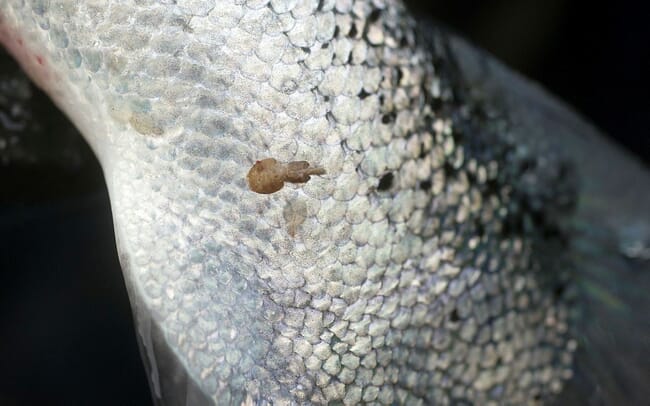
© Joe Urrutia, Nofima
While innovation in the salmon industry and strict rules have helped to reduce the severity of lice infestation on farms, welfare and environmental issues have been raised about the regular treatment methods and lice cost the salmon sector in Norway alone NOK 5 billion a year.
However, the new project aims to apply the gene editing tool that recently won the Nobel Prize for chemistry in a way that could make farmed salmon an unattractive host for sea lice.
“It is no exaggeration that the knowledge we create in this new project could transform the Norwegian aquaculture industry, if Atlantic salmon can be made to be highly or completely resistant to lice,” says project leader Nick Robinson, from Nofima. He has extensive experience of genetic and breeding research on disease resistance in aquatic species farmed worldwide.
Why gene editing?
This year, the Nobel Prize for chemistry was awarded to Emmanuelle Charpentier and Jennifer Doudna for the development of a gene editing method utilising CRISPR-Cas9 “genetic scissors”. This is the method that the researchers in this project will use as an ultimate test of which genes affect how attractive salmon is as a host to lice.
The genetic code influences the function and development of all living things. Differences in the genetic code make Atlantic salmon more attractive hosts than coho or pink salmon to lice. Such differences, for example, could result in the production of chemical attractants by Atlantic salmon but not by coho, or result in an effective defensive response of the salmon skin to newly-attached lice in pink salmon but not in Atlantic salmon.
“If we can reveal the differences in the genetic code that cause lice to be attracted to Atlantic salmon, or that makes the skin of North American salmon a bad place for sea lice to settle and develop, then it may be possible for us to use that information to make Atlantic salmon resistant to sea lice, and have better health,” says Robinson.
CRISPR-Cas9 is tool that makes it possible to make targeted changes to the genetic code. For instance, CRISPR-Cas9 could be used to delete a few base sequences of the code to disrupt a gene’s function. But an intense research effort is needed, first to determine which genes could be edited to have the desired effect, and secondly to be able to successfully make the desired edits.
“CRISPR-Cas9 is still a relatively new technology in the aquaculture research, but can allow for very precise and targeted changes at specific genes in the salmon genome known to be involved in cross-species variation in resistance to lice and the success of its use depends on the type of change that is needed and on the position and code of the gene to be edited,” says Professor Ross Houston of the Roslin Institute, whose team will work closely with Nofima on this and other parts of the project.

© Helge Skodvin, Nofima
Research needed to find promising genes
The researchers will find and measure the chemical components that each salmon species releases. Then they will test how sea lice react to each of the unique chemicals released by Atlantic salmon, and reveal which of them are semiochemicals that can attract or repel lice.
“We can observe whether lice are excited and stimulated to swim towards these chemicals,” says Howard Browman, of the Institute of Marine Research in Norway.
They will also undertake experiments to study the response to attached lice by different cell types in the salmon skin, and how this response differs in the resistant North American species.
Finally, the researchers will determine what genes are affecting the production of these semiochemicals and affecting the response of different cells in the skin, and test how these genes can be "disrupted" using CRISPR-Cas9 to make Atlantic salmon unattractive to lice.
Thorough testing
If the researchers succeed in carrying out gene editing in the laboratory, the salmon must be thoroughly tested up to adult size in closed facilities to investigate how effective the change is and to reveal any potential unwanted side-effects. Robinson emphasises that this project will not make genetically edited fish available to industry and that further testing will be needed. They will also consider risks of sea lice adapting to the changes in the salmon, and how this would be best prevented.
“Lice adapt to become resistant to chemical treatments, and we need to consider if they might adapt to overcome any specific changes that are made to Atlantic salmon,” says Tim Dempster from the University of Melbourne.
The project will also consider possible effects on wild salmon populations.
“In the project, we will determine how the changes would be best implemented in a farming population, to make all Norwegian farmed salmon resistant to lice,” says Robinson.
It is up to the aquaculture industry and the authorities, in consultation with other stakeholders, to determine whether these new tools can be deployed and, if so, the best approaches to their introduction.
The researchers will follow responsible research and innovation (RRI) guidelines.
“We will invite NGOs and others who are interested in seafood production to get input on what social and moral consequences the research and possible implementation could have for Norwegian society. With such input, we can adjust the work underway and create a responsible plan that balances animal welfare, ethics and law,” says Robinson.
The project will be led by the Norwegian Fisheries, Aquaculture and Food Research Institute – Nofima, and involve close collaboration with the research partners Roslin Institute (University of Edinburgh, UK), the Institute of Aquaculture (University of Stirling, UK), Rothamsted Research (UK), the University of Melbourne (Australia), University of Prince Edward Island (Canada), Bigelow Laboratory for Ocean Sciences (USA), University of Gothenburg (Sweden), and the Institute of Marine Research (Norway). Benchmark Genetics and Salmar are industry partners.



